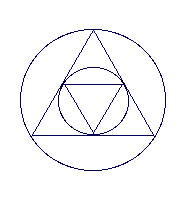Solutions to Brain-Twisters IV
The solutions too will often involve the use of figures and tables. As in the puzzles page, the figures are in gif format and should be downloadable by text-based browsers like Lynx.
Signs II and III contradict each other, so at least one of them is true. Since at most one of the three signs is true, then the first one must be false, so the lady is in Room I.
Since the sign of the room containing the lady is true, the lady certainly cannot be in Room II. If she is in Room III, then all three signs must be true, which is contrary to the given condition that at least one sign is false. Therefore, the lady is in Room I (and sign II is true and sign III is false).
Since the sign on the door of the room containing the lady is true, the lady cannot be in Room III. Suppose she is in Room II. Then sign II would be true; hence the tiger would be in Room I and Room III would be empty. This would mean that the sign on the door of the tiger's room would be true, which is not possible. Therefore, the lady is in Room I; Room III must then be empty, and the tiger is in Room II.
The easiest way is to inscribe another equilateral triangle as shown below:

It is at once obvious that the area of the small triangle is one-fourth that of the large triangle. Since the small circle and its inscribed triangle are simply the large circle and its triangle reduced in size, the circles must be reduced by the same proportion as the triangles. Therefore, the area of the small circle is also one-fourth that of the large circle.
Suppose there are E errors in total and that the first proof reader, A, finds 1/x of the errors, and the second, B, finds 1/y of them. Then E/x = 30 and E/y = 24.
Of the E/x that A found, B will have found 1/y, and so from the errors found by both,
E/xy = 20.
So the total expected number of errors is (30 x 24)/20 = 36. Between them they found 30 + 24 - 20 = 34, so it is expected that on average ony two errors remain undetected by either of them.
Return to:
Revised: Jnauary 6, 1997
